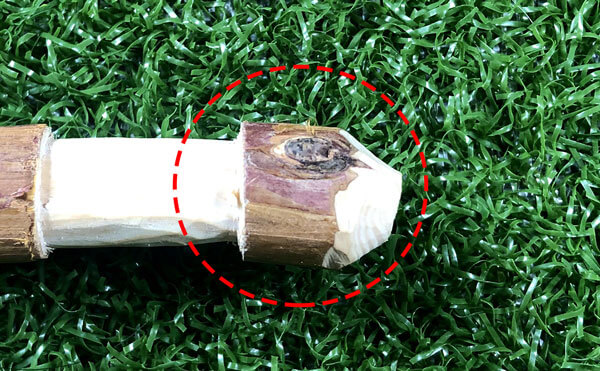ブラントエンド


トライスティックの解説ページ
トライスティックはブッシュクラフやサバイバルで使用されるノッチ(切り込み)やカットを、1本の枝にまとめて作成するスティックのこと。
ナイフの性能やナイフ捌きの見極め、ノッチ作成の練習が目的であり、作成後に何かに使用することはない。
カナダのブッシュクラフト・サバイバルインストラクターのモース・コハンスキー(Mors Kochanski)が広めた物で、改良されながら広まったので順番・ノッチの種類・ノッチの個数などは文献によってバラバラ。
切り方のの解説はノッチ一覧で解説しています。
上記の通り試し切りやナイフの扱いの練習として使用される。
基本的には購入したナイフで切りやすいノッチの把握や、研いだナイフの切れ味確認などに使われることが多い。
海外のブッシュクラフト協会などではスキルテストとしてトライスティックを活用している所も多々ある。
また浅く・深く・えぐる・切る・刺すなど色々な方法でノッチを作っていくので、ナイフの取り扱いの練習に向いている。
ノッチを切る練習でもありますが、キャンプやブッシュクラフトでは使わないノッチが多いので、ノッチの練習をするなら使うノッチのみを延々と切る方が上達が早いです。
トライスティックは木の枝を使用するので、山で拾って用意しておきましょう。
慣れていない方はトライスティックに理想な枝を拾うようにして、難易度を下げて練習するようにしましょう。
細すぎると折れやすく、太いと切るのが大変なので注意しましょう。
個人的にはナイフの刃を当てて枝を1周させるのに、ギリギリ持ち替えるくらいの太さを目安にしています。
枝の長さはノッチの数にもよりますが30cm以上の枝を用意しましょう。
ですが慣れるまでは長さは気にせずに足りなかったらアンラッキーくらいの気持ちでも大丈夫です。
そもそも枝の先端用のカットが5種あり、1本の枝で全てのノッチを切るのは不可能なので、長い枝よりも本数を集めるようにしましょう。
トライスティックでは基本的に節を避けて切るので、節が多いと使用できる面積が少なくなり使いにくいので節の少ない枝を選びましょう。
多少歪んでいても大丈夫ですが、極力真っ直ぐな枝を選ぶこと。それと丸い枝にすること。
曲がっていたり角が出ている枝や割れている枝はNG。
割れている枝は切りにくいのもありますが、切った場所から割れが拡大しやすく危ないので避けましょう。
枝によっては腐敗していたり虫に食われている物がありますが、そのような枝は急に柔らかくなることで、ナイフを素早く切り抜いてしまう原因になり危険なので注意しましょう。
針葉樹のほうが柔らかい木が多いので切りやすいですが、個人的にはキャンプやブッシュクラフトで実際に使用する枝(野営地に落ちている枝)を使うことが大事だと思っています。
ナイフの取り扱いの練習や切れ味のテストにも使われるので、基本的にはどんなナイフでも大丈夫ですがオピネルや肥後守などのフォールディングナイフのような不安定なナイフは避けるようにしましょう。
なるべくウッドクラフトに使用するナイフで行いましょう。
細かい作業が多いので刃厚が厚すぎるナイフや、刃長が長い大きいナイフは難易度が上がるので慣れていない時は慎重に扱うようにしましょう。
トライスティックは北欧由来のブッシュクラフで発案されたものなので、ナイフもフィンランドの伝統的なプーッコなんかオススメ。
コハンスキー曰く1ノッチ1分で切れとのこと。
意識して早く切らなくてもナイフの扱いやノッチのカットに慣れたら許容範囲なので、早く切る練習ではなくナイフの特性や切るコツを理解する練習をしていきましょう。
急いで切るのは手や指を深く切る原因にもなるので急ぐのは禁物です。
コハンスキーが作成したトライスティックの資料はこのサイトで無料で購入できます。もちろん英語。
ブッシュクラフト好きならコハンスキーのYoutubeや著書(英語)もオススメです。












木を切るような鋭利なナイフを使用するので、簡単に怪我をしてしまう危険があります。
注意しましょうというのは勿論、どんな人でも練習として何度もトライしていると1度は怪我をするのを頭の片隅に置いておきましょう。
跡が残るような深い傷ができる覚悟も必要です。
トライスティックはブッシュクラフトでは使用頻度の高いノッチも多いですが、通常のキャンプでは使用する機会がないので、無理に練習する必要はありません。